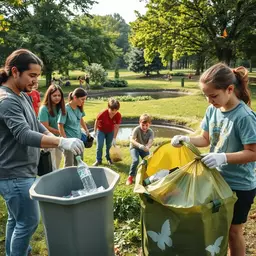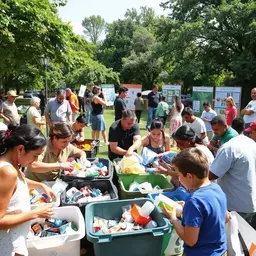Sustainable Tips for Suburban Living

As suburbs expand, their environmental impact often remains overlooked. However, every small change we make contributes to a greener future. What if your backyard could not only enhance your home but also play a vital role in combating climate change? Let’s explore practical tips for embracing a sustainable suburban lifestyle!
What You Will Learn
- Understanding the significant energy consumption and carbon emissions associated with suburban living.
- Simple energy-saving practices, such as switching to energy-efficient appliances and using LED light bulbs.
- Eco-friendly lawn care options, including the use of native plants and organic fertilizers.
- Transportation alternatives that can reduce emissions, such as public transport, biking, and carpooling.
- The benefits of community gardens for local food sourcing and enhancing community connections.
- Conducting a cost-benefit analysis for eco-friendly home upgrades to evaluate initial costs versus long-term savings.
- Identifying available grants and incentives for sustainable living, including tax credits and rebates for energy-efficient improvements.
- The importance of personal responsibility and community involvement in sustainability efforts for a healthier environment.
Environmental Impact of Suburban Living
Understanding the statistics related to suburban carbon emissions and the potential for eco-friendly changes can help us foster a more sustainable lifestyle.
Suburban Homes Energy Consumption
Suburban homes typically consume more energy per capita than urban homes, leading to higher carbon emissions.
Transportation Emissions
Transportation in suburban areas contributes nearly 60% of total greenhouse gas emissions.
Land Use Efficiency
Land use in the suburbs is often less efficient, leading to increased pollution and habitat disruption.
Eco-Friendly Changes
Implementing energy-efficient appliances, sustainable landscaping, and alternative transportation methods can significantly reduce our carbon footprint.
Embracing Sustainable Suburban Living: Practical Tips for a Greener Lifestyle
Living in the suburbs offers us a unique opportunity to create a vibrant, eco-friendly lifestyle right outside our front doors. At Greener Suburbs, I believe that small changes can add up to make a significant impact on our environment. By embracing sustainable practices, we can foster cleaner, healthier neighborhoods for ourselves and future generations. So, let’s dive into some practical tips to help us get started!
Understanding the Environmental Impact of Suburban Living
Did you know that suburban areas contribute significantly to carbon emissions and pollution? It’s true! As we enjoy the comforts of our spacious homes and green lawns, we can unintentionally create a larger carbon footprint. By understanding our impact, we can take steps toward a more sustainable lifestyle.
Statistics on Suburban Carbon Emissions and Pollution
Here are some eye-opening statistics to consider:
- Suburban homes typically consume more energy per capita than urban homes, leading to higher carbon emissions.
- Transportation in suburban areas contributes nearly 60% of total greenhouse gas emissions.
- Land use in the suburbs is often less efficient, leading to increased pollution and habitat disruption.
Recognizing these statistics helps us understand the need for eco-friendly changes in our communities. Together, we can make a difference!
Identifying Key Areas for Eco-Friendly Changes in Suburbia
Now that we recognize the environmental impact, let’s explore specific areas where we can implement sustainable changes in our suburban lives. By focusing on areas like energy consumption, lawn care, transportation, and local food sourcing, we can create a greener future.
Energy Consumption in Suburban Homes
One of the first steps we can take is to assess our energy usage. Here are some simple ways to reduce energy consumption:
- Switch to energy-efficient appliances.
- Consider using LED light bulbs to save electricity.
- Unplug devices when they’re not in use to avoid phantom energy use.
These small changes can lead to significant savings on energy bills and help reduce our carbon footprint!
Land Use and Lawn Care Practices
Many of us love our green lawns, but traditional lawn care practices often involve harmful chemicals and excessive water use. Instead, we can embrace sustainable landscaping options, as highlighted by EcoWatch's tips for suburban sustainability:
- Opt for native plants that require less water and maintenance.
- Use organic fertilizers and pest control methods.
- Implement mulching to reduce the need for watering and weed control.
By making these shifts, we can create beautiful, eco-friendly spaces that benefit our neighborhoods and the environment.
Transportation Choices in Suburban Areas
Transportation is another crucial area where we can make a difference. Consider these options to reduce our carbon emissions:
- Use public transportation when possible, or carpool with neighbors.
- Explore biking or walking for short trips.
- Invest in electric or hybrid vehicles to reduce reliance on fossil fuels.
By changing our transportation habits, we can help clear the air in our communities!
Community Gardens: Fostering Local Food Sourcing
Community gardens can play a vital role in promoting sustainable living. They offer a chance to grow our own food and foster connections with neighbors. Consider starting a community garden in your area. Here are some benefits:
- They provide fresh, organic produce while reducing the carbon footprint of food transport.
- They enhance community connections and build friendships.
- They educate residents about sustainable gardening practices.
Let’s plant the seeds for a greener future together, one garden at a time!
Energy Efficiency Strategies for Suburban Homes
As we strive to make our suburbs more sustainable, focusing on energy efficiency in our homes is essential. Simple tweaks and innovations can lead to substantial benefits for both the environment and our wallets!
Quick Summary
Here's a brief recap of the key points discussed so far:
- Understanding Impact: Suburban living contributes significantly to carbon emissions; recognizing this impact is crucial.
- Eco-Friendly Changes: Focus on energy consumption, lawn care, transportation, and local food sourcing to foster a sustainable lifestyle.
- Community Engagement: Local initiatives, like community gardens, can enhance sustainability and strengthen neighborhood bonds.
Frequently Asked Questions About Sustainable Suburban Living
- Q: Why is sustainable living important in suburban areas?
- A: Suburban areas often have a significant environmental impact due to higher energy consumption in homes, increased transportation emissions, and less efficient land use. Embracing sustainable practices helps reduce carbon footprints, conserve resources, and create healthier communities.
- Q: What are some simple ways to reduce energy consumption at home?
- A: You can reduce energy consumption by switching to energy-efficient appliances, using LED light bulbs, and unplugging electronics when not in use to avoid "phantom load."
- Q: How can I make my lawn care more eco-friendly?
- A: Opt for native plants that require less water and maintenance, use organic fertilizers and pest control methods, and implement mulching to reduce the need for watering and weed control.
- Q: What transportation alternatives can help reduce my carbon footprint?
- A: Consider using public transportation, carpooling, biking, or walking for short trips. Investing in electric or hybrid vehicles is also a great way to reduce reliance on fossil fuels.
- Q: What are the benefits of community gardens?
- A: Community gardens provide fresh, organic produce, reduce the carbon footprint associated with food transport, enhance community connections, and educate residents about sustainable gardening practices.
- Q: Are there financial incentives for making eco-friendly home upgrades?
- A: Yes, many local, state, and federal programs offer grants, tax credits, and rebates for energy-efficient improvements and renewable energy installations. It's worth exploring these resources to help offset initial costs.
Budgeting for Eco-Friendly Upgrades: Balancing Costs and Benefits
When it comes to making our homes more sustainable, budgeting can feel like a daunting task. However, the good news is that many eco-friendly upgrades can save you money in the long run! I’ve found that taking a step back and analyzing the costs versus the benefits really helps in making informed decisions. By investing in energy-efficient appliances or renewable energy sources, you can significantly lower your utility bills and make a positive impact on the environment.
To start, it’s essential to conduct a thorough cost-benefit analysis for each upgrade you’re considering. Ask yourself questions like: How much will this cost initially? What will my savings be over time? By answering these questions, you’ll be able to prioritize which upgrades are most beneficial for your home and wallet!
Conducting a Cost-Benefit Analysis for Green Improvements
So, what does a cost-benefit analysis look like for eco-friendly upgrades? Here are some steps to guide you:
- **List the upgrades**: Start by writing down all the energy-efficient changes you’re contemplating, such as solar panels, energy-efficient appliances, or insulation improvements.
- **Estimate costs**: Research the initial costs involved in each upgrade. Don’t forget to include installation fees where applicable!
- **Calculate savings**: Look up how much you could save on energy bills with each upgrade. It’s helpful to get estimates from your utility company.
- **Evaluate long-term impact**: Consider any additional benefits, like increased home value or potential tax breaks for sustainable upgrades.
By following these steps, I believe you’ll find that many green upgrades can pay for themselves over time! Plus, you’ll feel great knowing that your home is contributing to a healthier planet.
Identifying Grants and Incentives for Sustainable Living
Additionally, don’t underestimate the power of available financial assistance! Many local, state, and federal programs offer grants and incentives to help residents make eco-friendly improvements, a topic often explored by the EPA's resources for sustainable communities and their support for sustainable rural communities. Here are a few types of support you might find:
- Tax credits: These can significantly reduce your overall tax bill for renewable energy installations.
- Rebates: Some utility companies provide rebates for purchasing energy-efficient appliances.
- Low-interest loans: Certain programs offer loans at reduced interest rates for green home improvements.
Finding these resources isn’t just beneficial; it can make the difference between a dream upgrade and a reality! At Greener Suburbs, we aim to keep our community informed about local initiatives that support sustainable living, so feel free to reach out if you have questions!
Conclusion: Taking Action Towards a Sustainable Future in Suburbia
As we wrap up our journey toward a greener lifestyle, remember that every small action counts! It’s all about taking steps, even if they seem tiny, to contribute to our beautiful suburban environment. Whether you’re budgeting for eco-friendly upgrades or participating in community initiatives, you’re making a difference. I encourage you to share your progress and inspire others to join the movement!
Encouraging Personal Responsibility and Community Action
Getting involved in local sustainability efforts is a fantastic way to connect with others who share your passion for the environment. Together, we can advocate for eco-friendly policies and participate in initiatives that benefit our neighborhoods. So, why not start by hosting a community meeting or workshop to discuss local efforts? Sharing knowledge and experiences can ignite action and motivate others!
Resources for Continued Learning and Engagement
If you’re eager to learn more about sustainable practices, there are countless resources available. Here are a few to consider:
- Local workshops: Check for events hosted by Greener Suburbs or nearby organizations.
- Online courses: Platforms like Coursera and Udemy offer classes on sustainability and eco-friendly practices.
- Community groups: Join local Facebook groups or community forums focused on sustainability.
Join the Movement for Eco-Friendly Suburban Living
Finally, let’s talk about connection! Joining local groups or online communities can keep you motivated and informed about the latest trends in eco-friendly living. At Greener Suburbs, we're always welcoming new members who want to make a positive change. It’s a fantastic way to meet like-minded neighbors while working towards a common goal!
Connecting with Local Groups and Online Communities
Engaging with others amplifies our efforts. Here are a few ways to connect:
- Attend local events: Participating in neighborhood cleanups or workshops is a great way to network!
- Utilize social media: Platforms like Instagram and Facebook are perfect for joining groups focused on sustainability.
- Create a neighborhood group: Start your own initiative to discuss eco-friendly practices and share tips.
Every bit of effort counts, and together, we can build a more sustainable suburban future! Let's take action, inspire change, and create the vibrant, green neighborhoods we all dream of.
Recap of Key Points
Here is a quick recap of the important points discussed in the article:
- Suburban living contributes significantly to carbon emissions, making sustainable practices crucial.
- Reducing energy consumption can be achieved by using energy-efficient appliances and LED bulbs.
- Sustainable lawn care includes opting for native plants and using organic fertilizers.
- Transportation can be improved by using public transport, carpooling, or biking for short trips.
- Community gardens promote local food sourcing and strengthen community ties.
- Conducting a cost-benefit analysis helps prioritize eco-friendly upgrades for homes.
- Explore grants and incentives available for sustainable home improvements.
- Engage in local sustainability efforts to inspire and connect with like-minded individuals.
Popular Posts
 What if your next weekend could help restore local wildlife habitats while beautifying your communit
What if your next weekend could help restore local wildlife habitats while beautifying your communit
 What if your local business could lead the charge in transforming your community into a recycling po
What if your local business could lead the charge in transforming your community into a recycling po
 Gardening isn’t just a pastime; it’s a chance to make a difference in our suburban landscapes. B
Gardening isn’t just a pastime; it’s a chance to make a difference in our suburban landscapes. B
 Did you know that creating an eco-friendly garden can significantly enhance your home’s value and
Did you know that creating an eco-friendly garden can significantly enhance your home’s value and
